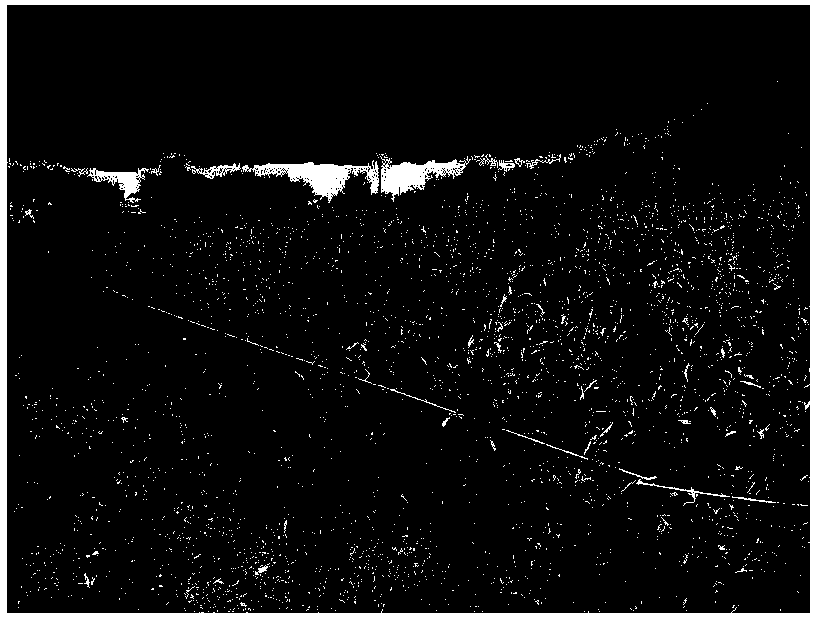Method for remediating contaminated soil by field planting of willow micro-cuttings
A technology of polluted soil and willow, which is applied in the field of soil remediation, can solve the problems of poor growth, affecting the early growth of cuttings, and strong toxicity, so as to promote plant biological production and pollutant removal, save plant colonization time and economic costs, and high The effect of survival rate and seedling rate
- Summary
- Abstract
- Description
- Claims
- Application Information
AI Technical Summary
Problems solved by technology
Method used
Image
Examples
Embodiment 1
[0036] Embodiment 1 A kind of method of repairing polluted soil by willow micro-cuttings field planting of the present invention, comprises the following steps:
[0037] 1) Reserve cuttings and branches
[0038] Select the 3-year-old Artemisia willow with more branches and strong growth, and select the ear-picking plants with strong growth and strong tillering ability for pruning to promote the germination and growth of 1-2-year-old branches.
[0039] 2) Site pretreatment
[0040] From late February to early March of the following year, leveling will be carried out at the heavy metal contaminated soil remediation test site.
[0041] 3) Preparation of propagules
[0042] From mid-to-late March to early April, before the plant buds germinate, select 1-2-year-old branches with a diameter of about 1.0-1.5 cm from the robust seedlings of the excellent clone Artemisia willow, and use a cutting machine to cut off 4-5 cm long cuttings, keeping only 1 -3 leaf buds, prepared as oligo...
Embodiment 2
[0049] Embodiment 2 A kind of method of repairing polluted soil by willow micro-cuttings field planting of the present invention comprises the following steps:
[0050] 1) Reserve cuttings and branches
[0051] Choose the 2-year-old American bamboo willow with more branches and strong growth, and select the fringe-picking plants with strong growth and strong tillering ability for pruning to promote the germination and growth of 1-2-year-old branches.
[0052] 2) Site pretreatment
[0053] From late February to early March of the following year, leveling will be carried out at the heavy metal contaminated soil remediation test site.
[0054] 3) Preparation of propagules
[0055] From mid-to-late March to early April, before the plant buds germinate, select 1-2-year-old branches with a diameter of about 1.0-1.5 cm from the robust seedlings of the excellent clone Artemisia willow, and use a cutting machine to cut off 4-5 cm long cuttings, keeping only 1 -3 leaf buds, prepared ...
Embodiment 3
[0062] Embodiment 3 A kind of method of repairing polluted soil by willow micro-cuttings colonization of the present invention comprises the following steps:
[0063] 1) Reserve cuttings and branches
[0064] Choose 3-4 year-old weeping willows with more branches and strong growth, and select ear-picking plants with strong growth and strong tillering ability for pruning to promote the germination and growth of 1-2 year-old branches.
[0065] 2) Site pretreatment
[0066] From late February to early March of the following year, leveling will be carried out at the heavy metal contaminated soil remediation test site.
[0067] 3) Preparation of propagules
[0068] From mid-to-late March to early April, before the plant buds germinate, select strong seedlings of 1-2 years old weeping willow clones with a diameter of about 1.0-1.5cm, and use a cutting machine to cut off 4-5cm long cuttings, keeping only 1-3 leaf buds were prepared into oligo-bud micro-cutting propagules.
[0069...
PUM
 Login to View More
Login to View More Abstract
Description
Claims
Application Information
 Login to View More
Login to View More - R&D
- Intellectual Property
- Life Sciences
- Materials
- Tech Scout
- Unparalleled Data Quality
- Higher Quality Content
- 60% Fewer Hallucinations
Browse by: Latest US Patents, China's latest patents, Technical Efficacy Thesaurus, Application Domain, Technology Topic, Popular Technical Reports.
© 2025 PatSnap. All rights reserved.Legal|Privacy policy|Modern Slavery Act Transparency Statement|Sitemap|About US| Contact US: help@patsnap.com



